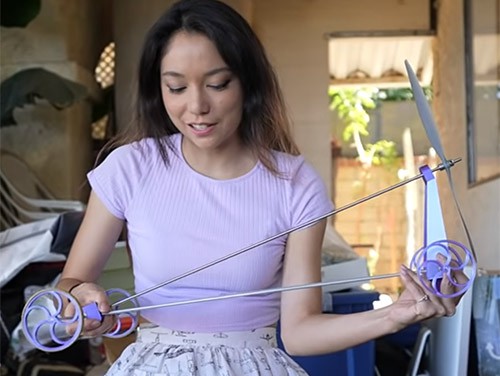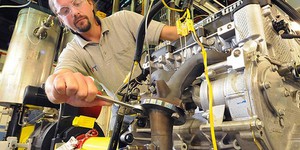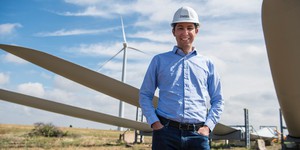Abstract
Is it possible for an entirely wind-powered vehicle to travel directly downwind faster than the wind? This might seem counterintuitive or like it would violate the law of conservation of energy. After all, any good scientist knows that perpetual motion machines are impossible. However, as demonstrated by YouTubers Rick Cavallaro, Derek Muller (Veritasium), and Xyla Foxlin, you can take advantage of some tricky physics to make this vehicle work. Can you build—or even improve—your own "impossible" wind-powered vehicle for your own science project? Try it and find out!Summary
Based on "Building the Vehicle Physicists Called Impossible (feat. Veritasium)" by Xyla Foxlin.
Objective
Build a working model of an entirely wind-powered vehicle that can travel directly downwind faster than the wind.
Introduction
Watch the following video by YouTuber Derek Muller (Veritasium), which introduces an "impossible" wind-powered vehicle called "Blackbird," built by Rick Cavallaro. Blackbird is powered entirely by the wind—no hidden batteries or other power sources! The vehicle in the video uses some counterintuitive physics. You might expect that the propeller would behave like a wind turbine, which harnesses power from the wind, spinning the wheels to propel the vehicle forward. However, the behavior is actually the opposite: the drag force from the wind on the body of the car pushes it forward, spinning the wheels. The wheels are connected to the propeller with gears and chains, causing it to spin and act like a fan: it blows air backwards and pushes the car forward (due to Newton's third law of motion).
Either way, you might expect it to be impossible for this vehicle to go faster than the wind. Wouldn't that violate the law of conservation of energy? YouTube is full of bogus claims about perpetual motion machines—is this just another hoax? Or, could there be some fundamental errors in the experiment and data collection that just made it seem like Blackbird was traveling faster than the wind? UCLA physics professor Alexander Kusenko thought the latter, and was willing to bet $10,000 that Blackbird's operation was impossible—at least, as Veritasium described it. You can learn about that bet—and the results—in this video:
Most people do not have the means to build a full-size vehicle like Blackbird, or access to a windy dry lake bed to test it. Thankfully, engineer and YouTuber Xyla Foxlin developed plans for a miniature version of Blackbird that you can build using a 3D printer and parts you can buy online or at a hobby store. You can use her plans to build your own car and demonstrate its operation. Can you devise an experiment to test how changing a variable affects the car's performance using the scientific method? Can you make changes to improve the design using the engineering design process? You won't know until you build one, so try it and find out!
Terms and Concepts
- Wind turbine
- Drag
- Gears
- Newton's third law of motion
- Conservation of energy
- Perpetual motion machines
Questions
- How does the Blackbird vehicle work?
- How is it possible for the vehicle to move downwind faster than the wind, if it is only powered by the wind?
- Does this violate conservation of energy?
- Which variables could you test when building your own wind-powered vehicle?
- Which independent variable(s) could you change?
- Which dependent variable(s) could you measure?
- How could you define the car's "performance"?
- How would you measure this performance?
Bibliography
- Cavallaro, R. (2008, November 15). Downwind Faster than the Wind (DWFTTW) Myth Challenge. Retrieved July 13, 2021.
- Muller, D. (2021, May 29). Risking My Life To Settle A Physics Debate. Retrieved July 13, 2021.
- Muller, D. (2021, May 29). A Physics Prof Bet me $10,000 I'm Wrong. Retrieved July 13, 2021.
- Foxlin, X. (2021, June 30). Building the Vehicle Physicists Called Impossible (feat. Veritasium). Retrieved July 13, 2021.
- Science Buddies Staff (n.d.). Comparing the Engineering Design Process and the Scientific Method. Science Buddies. Retrieved July 13, 2021.
Materials and Equipment
The following materials are recommended by Xyla Foxlin in the description of her YouTube video. You may also be able to purchase some of the materials at a local hobby shop. Listed quantities are exactly what is required to build one cart, but Xyla recommends purchasing extra parts in case some break, especially ball bearings and plastic gears. You will also need to plan whether you need additional parts for your experiment; for example, you might want to test different gear ratios or different propellers.
- Access to a 3D printer
- CAD files for 3D printing car parts. Note that the files are in inches and you will need to scale accordingly in your 3D printing software.
- McMaster-Carr parts and part numbers:
- 12205T79: Natural Rubber Bands Size 73, 3/8" Wide x 3" Long (1)
- 60355K42: Ball Bearing Shielded, Trade No. R3-2Z, for 3/16" Shaft Diameter (6)
- 7297K12: Plastic Miter Gear 48 Pitch, 24 Teeth (2)
- 1263K55: Rotary Shaft 316 Stainless Steel, 3/16" Diameter, 24" Long (2)
- 8978K113: Rigid Aluminum Tubing 3/16" OD, 0.022" Wall Thickness, 490 PSI Maximum Pressure, 3' Long (2)
- 6432K19: Set Screw Shaft Collar for 3/16" Diameter, Zinc-Plated 1215 Carbon Steel (2)
- Propeller
- Recommended, but not included in Xyla's design: Material to build a protective guard for the propeller to prevent cuts from inadvertently bumping the propeller, similar to the guards that prevent propeller damage on many quadcopters. Simple craft materials (balsa wood, craft sticks, cardboard, etc.) should be sufficient; you do not need to buy additional aluminum or steel pieces from McMaster-Carr.
- Somewhere to test your car:
- A treadmill for testing indoors
- A flat, open, outdoor area (like a tennis or basketball court) with steady wind
- Appropriate measurement equipment for your experiment. This will vary depending on what you decide to test and measure. For example:
- If testing outside, you might need an anemometer to measure wind speed.
- You may need a way to measure the car's speed; for example, a stopwatch and two lines on the ground a known distance apart.
- Alternatively, you could set up a camera on a tripod and film the car from the side, then analyze the video to determine the car's speed.
Disclaimer: Science Buddies participates in affiliate programs with Home Science Tools, Amazon.com, Carolina Biological, and Jameco Electronics. Proceeds from the affiliate programs help support Science Buddies, a 501(c)(3) public charity, and keep our resources free for everyone. Our top priority is student learning. If you have any comments (positive or negative) related to purchases you've made for science projects from recommendations on our site, please let us know. Write to us at scibuddy@sciencebuddies.org.
Experimental Procedure
- This is an open-ended project, so it requires some planning on your part before you get started. The two suggestions here are just that—suggestions. You may choose to follow a different experimental procedure.
- For the scientific method:
- Choose one thing about the car to change (the independent variable). For example, you could use different propeller diameters or different gear ratios (remember that this means you will need to purchase additional parts beyond what is listed in the materials section).
- If you are testing the car outdoors, you can measure the car's speed relative to the wind speed as your dependent variable. Make sure you do many trials in order to account for variation in wind speed.
- If you are testing the car indoors on a treadmill, you can measure the car's forward speed on the treadmill as your dependent variable.
- For the engineering design process:
- Choose something about the car that you want to improve. For example, do you want to make it cheaper to build? Sturdier? Smaller? Make it go straighter so it does not crash? Make it from different materials so it does not require a 3D printer?
- Define how you will measure the car's performance. This could be similar to the speed measurements for the scientific method, but it could be something else (e.g. how far or how long the car can drive before crashing), and it might include multiple factors (e.g. speed and cost).
- There might be some overlap between the scientific method and engineering design process, and you might wind up using both in your project. For example, if your engineering goal is to make the car faster, it could make sense to use the scientific method to test different variables to see how they affect the car's speed.
- For the scientific method:
- Build your car by following the instructions in Xyla Foxlin's video. Science Buddies recommends adding a protective guard around the propeller to prevent accidental cuts, especially when operating the car on a treadmill. Depending on your exact procedure, you might need to make sure it is easy to swap out parts (e.g. propellers) on your car, or build more than one car to test.
- Follow either the scientific method or the engineering design process to test and/or improve your car.
- Communicate your results! Did you determine how a certain variable affects the speed of the car, or were you able to make improvements to Xyla's design? Make sure you are prepared to explain how the car works, as you might run into people who claim your car must be a hoax and is "impossible" (e.g. it must have a hidden battery somewhere).
Ask an Expert
Global Connections
The United Nations Sustainable Development Goals (UNSDGs) are a blueprint to achieve a better and more sustainable future for all.
Variations
- Can you build a car that is a more exact replica of the Blackbird vehicle (with the propeller perpendicular to the ground) using gears and a chain?
- Can you build a larger (or smaller) version of the car?
Careers
If you like this project, you might enjoy exploring these related careers:
Related Links
- Science Fair Project Guide
- Other Ideas Like This
- Mechanical Engineering Project Ideas
- Physics Project Ideas
- My Favorites
















